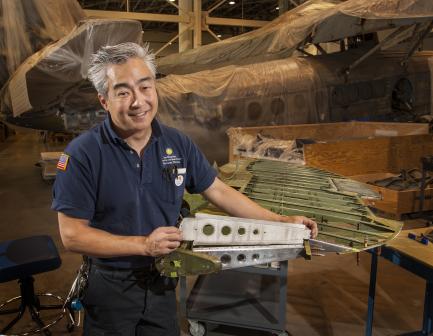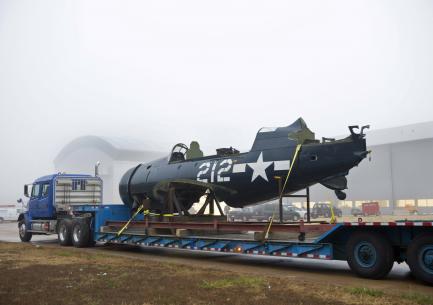National Air and Space Museum Unveils Helldiver
A World War II dive-bomber, the Curtiss SB2C-5 Helldiver, will go on exhibition April 1 at the Smithsonian’s Steven F. Udvar-Hazy Center, where it has been undergoing restoration for the past 15 months. It is the first historic aircraft to be restored in the Mary Baker Engen Restoration Hangar, which is part of a major new addition to the center, also consisting of several artifact storage facilities, a collection processing unit, the Emil Buehler Conservation Laboratory and the museum’s Archives. The restoration hangar, large enough to hold seven aircraft at the same time, is fully visible from a mezzanine above, where museum visitors can view specialists working on artifacts below.
The museum’s Helldiver rolled off the assembly line in Columbus, Ohio, in May 1945, four months before the war ended. It never saw combat. From September through December of that year, it was located on the USS Lexington and flown by Bombing Squadron (VB) 92 in the western Pacific and, later, in occupied Japan. It was transferred by the U.S. Navy to the Smithsonian in 1960.
“With the Mary Baker Engen Restoration Hangar now fully operational, we can expect to see other icons being transformed, as they move from storage, through restoration and into full view on the exhibition floor of the Udvar-Hazy Center,” said Gen. J.R. “Jack” Dailey, director of the museum.
Support for the Mary Baker Engen Restoration Hangar included a donation of $15 million from Travis and Anne Engen, the son and daughter-in-law of Vice Adm. Donald D. Engen, a former director of the museum, who flew Helldivers in World War II. In appreciation for the gift, the museum named the hangar after Adm. Engen’s wife, Mary.
The restoration of the museum’s Helldiver was aided by two surviving members of VB 92, who provided aeronautics curator Jeremy Kinney with firsthand knowledge of its use on the Lexington; the children of other members donated a squadron yearbook with photographs documenting its unique markings. Another source of information was a former member of the Curtiss-Wright Engineering Cadettes, who inspected Helldivers at the Ohio plant in May 1945. The Cadettes were women engineers during World War II.
The restored Helldiver boasts new paint and markings that take it back to its days with VB-92 during the fall of 1945. The engine received a thorough cleaning and preservation treatment. It has a fully restored propeller with significant details that had been lost for decades. Interior areas in the fuselage were preserved, as were the wings, to stabilize corrosion and retain the original Curtiss Green paint as much as possible. The Helldiver was reconstructed where needed. Museum Collections specialists replicated important parts of the aircraft, including the rear cockpit floor, the gun truck that connects the twin .30-caliber machine guns to the rear seat and the unique Curtiss-specific fabric coverings for the ailerons, elevators and rudder. Heavily damaged components, primarily the rudder and a torn outer wing panel, required extensive repair.
During World War II, U.S. Navy bombing squadrons flew Helldiver dive-bombers against Japan from November 1943 until the war’s end in September 1945. About 30 Navy squadrons operated Helldivers aboard 13 carriers. Changes in carrier tactics, technology and weapons made dive-bombing—delivering a bomb at a steep angle to increase accuracy—obsolete as the war progressed. The Helldiver was the last dive-bomber operated by the Navy and the last significant combat aircraft produced by Curtiss-Wright Corporation.
The Udvar-Hazy Center, which opened in December 2003, includes two exhibition halls, the Boeing Aviation Hangar and James S. McDonnell Space Hangar, in addition to the Restoration Hangar.
The National Air and Space Museum building on the National Mall in Washington, D.C., is located at Sixth Street and Independence Avenue S.W. The museum’s Steven F. Udvar-Hazy Center is located in Chantilly, Va., near Washington Dulles International Airport. Attendance at both buildings combined exceeded 8 million in 2013, making it the most visited museum in America. The museum’s research, collections, exhibitions and programs focus on aeronautical history, space history and planetary studies. Both buildings are open from 10 a.m. until 5:30 p.m. every day (closed Dec. 25).
# # #
SI-143-2014
Alison Wood
202-633-2376











